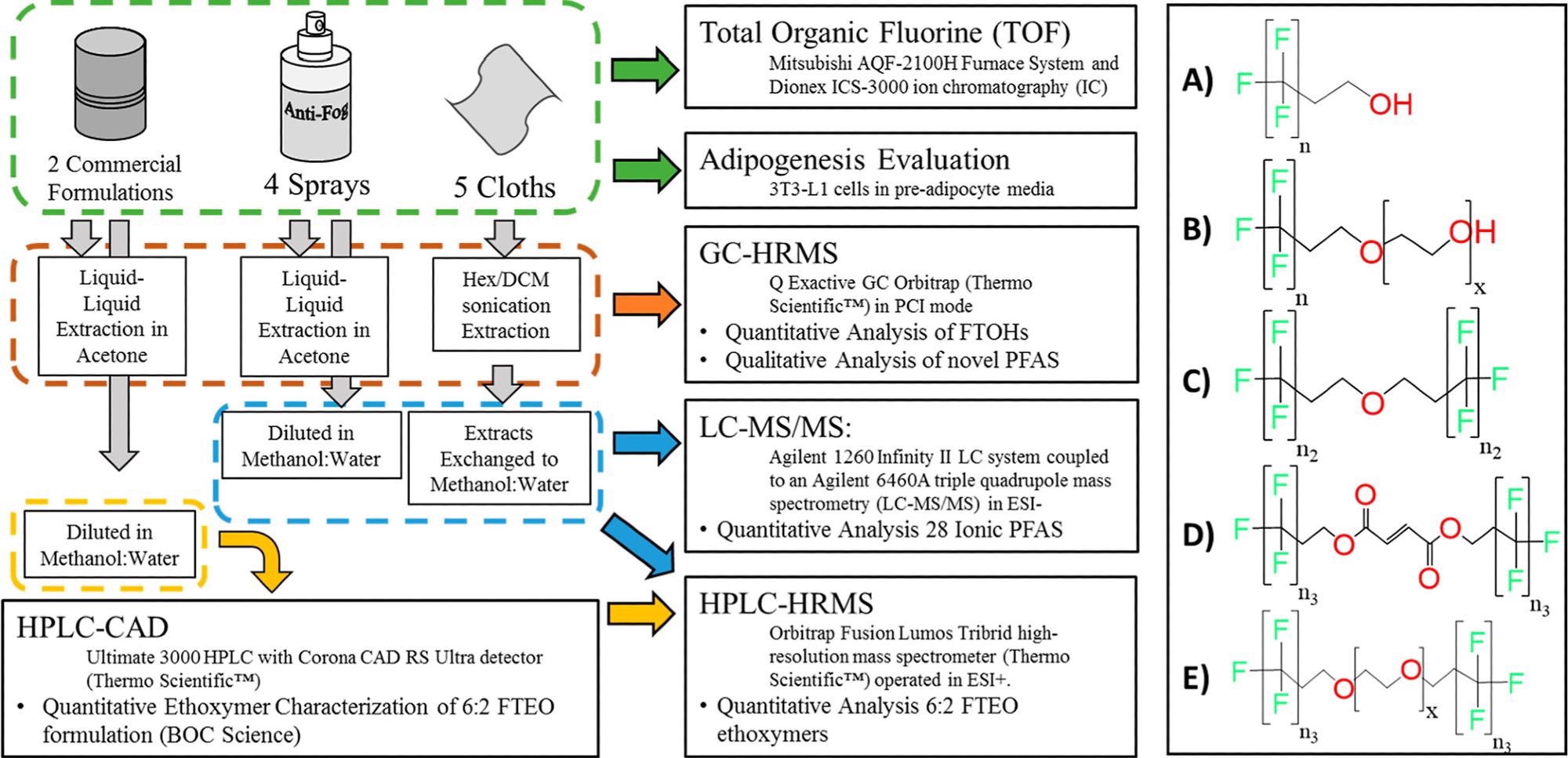I purchased one that was highly rated, but after receiving it, I looked at the ingredient list and saw the phrase “fluoroaliphatic oxyethylene adduct” listed. This raised my alarm bells and I was concerned that this spray may contain elevated levels of PFAS.
At that point, I spoke to Dr. Herkert and we decided to analyze the spray on our mass spectrometers. Sure enough, several different types of PFAS were detected. This piqued our interest and we decided to conduct a more robust study to test other products and examine their toxicity.
What are PFAS and how do they affect human health? Are there any populations who are particularly vulnerable to these chemicals?
Nick: Per- and Polyfluorinated Alkyl Substances (PFAS) are a large class of chemical compounds that have been used for decades for their stain- and water-repellent properties in commercial products. Due to the widespread use of PFAS, they can be detected in almost every human body.
Some PFAS have been shown to have a number of toxicological effects in lab-based studies and have been associated with several human diseases and conditions, including thyroid disorders, immunotoxic effects, and various cancers. The most vulnerable populations would be young children, pregnant women, elderly people, or people with underlying immune conditions.

Image Credit: Albina Gavrilovic/Shutterstock.com
Despite some PFAS substances being known to be toxic, some substances such as fluorotelomer alcohols (FTOHs) and fluorotelomer ethoxylates (FTEOs) are understudied. Why is this and why is it important to investigate the impact all PFAS can have on human health?
Nick: PFAS are a large (several thousand), and continually growing, class of compounds. Most research to date has focused on legacy PFAS compounds, or PFAS that are better studied such as PFOA and PFOS, simply because they have been around longer. With the increased awareness around the toxicity of these legacy long-chain PFAS, alternative PFAS (such as FTOHs, Gen-X, and many other PFAS compounds) were introduced as “safer” alternatives. As the tools that investigators use to detect PFAS improve, we have been able to identify new PFAS of concern (based on high prevalence or high toxicity) and more thoroughly characterize a large number of PFAS.
It’s very important to research the impact of PFAS on human health because they are very persistent in the environment and human body, and much is still unknown about the toxicity of the “safer” alternatives currently being used. And importantly, studies have shown that these “safer” alternatives can break down in the body to toxic PFAS. For example, previous studies have shown that FTOHs can break down in the body to the more persistent and toxic PFOA.
Can you describe how you carried out your latest research into PFAS? What did you discover?
Nick: In the current study, commercially available anti-fog spray and wipe products were analyzed for the presence of PFAS compounds. We found that all the anti-fog products we tested contained a significant amount of PFAS. Much of the PFAS was accounted for by FTOHs and fluorotelomer ethoxylates (FTEOs), which we know very little about.
To put these levels in context, if we assume FTOHs and FTEOs have similar toxicity to PFOA, the exposure from one pump of an antifog spray is 10-500x greater than exposure one would receive from consuming 1 liter of water at the U.S. EPA health advisory level (HAL) for PFOS/PFOA of 70 part per trillion (ng/L).
In addition, to thoroughly characterize the product for their PFAS levels, we also tested their toxicity in cell culture. All anti-fog spray products exhibited significant cytotoxicity and adipogenic activity in our assays, implicating them as potential metabolic and endocrine disruptors. FTEOs specifically, seemed to be the significant driver of the activity we observed in our assays.
Importantly, the activity was observed at levels less than the dose applied to eyeglasses (i.e. from one pump of the spray), meaning that toxicity was observed at exposures that are likely occurring when these products are being used.

Image Credit: Environ. Sci. Technol. 2022
What more should governments and policymakers be doing to raise awareness surrounding the potential problems associated with PFAS?
Heather: I think governments need to work more closely with chemical manufacturers and convince them to take more responsibility for their products. We need more transparency in where these products are used so consumers can make informed decisions about whether or not they choose to be potentially exposed to PFAS.
Furthermore, chemical manufacturers have made billions of dollars on these chemicals, yet PFOA and PFOS in particular have contaminated the drinking water supplies for millions of people, leaving consumers and water utilities with the bill to install more expensive water filtration technologies to remove them. The burden should be shifted to the chemical manufacturers to help clean up our drinking water.
What are the next steps for you and your research?
Heather: We are continuing to conduct research on PFAS and understand other materials and products that could contain these chemicals. Since manufacturers are not required to list the chemical treatments and ingredients, the use of PFAS in materials is often confidential. We are hoping we can raise more awareness of where and how PFAS are used to inform risk assessment
Where can readers find more information?
Lab Website: https://sites.nicholas.duke.edu/stapletonlab/research/pfas-research/
Press Release: https://nicholas.duke.edu/news/high-levels-pfas-found-anti-fogging-sprays-and-cloths
Article Link: https://pubs.acs.org/doi/10.1021/acs.est.1c06990
About Professor Heather Stapleton
Professor Heather Stapleton is an environmental chemist and exposure scientist in the Nicholas School of the Environment at Duke University. Her research interests focus on the identification of halogenated and organophosphate chemicals in consumer products and building materials and estimation of human exposure, particularly in vulnerable populations such as pregnant women and children. .jpg)
Her laboratory specializes in the analysis of environmental and biological tissues for organic contaminants to support environmental health research. Currently, she serves as the Director for the Duke Superfund Research Center, and Director of the Duke Environmental Analysis Laboratory, which is part of NIH’s Human Health Environmental Analysis Resource.
About Dr. Nicholas Herkert
Nicholas Herkert, Ph.D., is a Research Project Manager in the Nicholas School for the Environmental at Duke University and the Targeted Organic Analysis Manager of the Duke HHEAR Environmental Analysis Laboratory. Herkert received his doctorate in Environmental Engineering at the University of Iowa under the advisement of Professor Keri Hornbuckle..jpg)